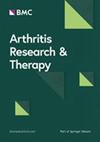The effect of hydroxychloroquine on activities of daily living and hand function in systemic sclerosis: results from an analysis of the EUSTAR cohort
IF 4.9
2区 医学
Q1 Medicine
引用次数: 0
Abstract
To evaluate the use of hydroxychloroquine (HCQ) and its impact on the Health Assessment Questionnaire disability index(HAQ-DI) and the Cochin Hand Function Status(CHFS) in a large Systemic Sclerosis (SSc) cohort. SSc patients from the European Scleroderma Trials and Research (EUSTAR) database treated with HCQ for at least 6 months were evaluated and compared to a matched group of SSc patients not using HCQ. Demographic and clinical data, concomitant drugs, HAQ-DI and CHFS (at least 2 evaluations) were recorded and were the outcome variables of interest. Statistical analysis was performed using propensity score matching for age, gender, disease duration, corticosteroids, immunosuppressives, vasoactive drugs in a 3:1 control: HCQ ratio. Standard descriptive statistics and Student’s t-test and Chi-square test were used to assess the propensity-matched groups. Out of 17,805 SSc patients evaluated, 468 (2.6%) used HCQ and constituted the HCQ group. Among them, 50 (10.7%) had at least a baseline and follow-up HAQ-DI evaluation and 44 (9.4%) had at least a baseline and follow-up CHFS evaluation. Propensity matching assured that patients were matched for female gender (HCQ vs. control 92.0% vs. 85.3%), mean age (49.8 vs. 50.0 years) disease duration (8.3 vs. 9.1 years), limited disease (55.3 vs. 62.6%) as well as background medications (all P > 0.1). We did not find any significant differences among the two groups in the change of HAQ-DI or CHFS, over up to 365 days (all P > 0.05). Results from the EUSTAR registry showed that HCQ was used by 2.6% of SSc patients. HCQ use did not improve the HAQ-DI, or CHFS when comparing HCQ users to non-HCQ users.羟氯喹对系统性硬化症患者日常生活活动和手功能的影响:来自EUSTAR队列分析的结果
评价羟氯喹(HCQ)的使用及其对系统性硬化症(SSc)大队列健康评估问卷残疾指数(HAQ-DI)和科钦手功能状态(CHFS)的影响。对欧洲硬皮病试验与研究(EUSTAR)数据库中接受HCQ治疗至少6个月的SSc患者进行评估,并与未使用HCQ的匹配组SSc患者进行比较。记录人口统计学和临床数据、伴随药物、HAQ-DI和CHFS(至少2项评估),这些都是值得关注的结果变量。采用倾向评分匹配年龄、性别、病程、皮质类固醇、免疫抑制剂、血管活性药物,以3:1对照:HCQ比进行统计分析。采用标准描述性统计、学生t检验和卡方检验评价倾向匹配组。在17,805例SSc患者中,468例(2.6%)使用HCQ,构成HCQ组。其中50例(10.7%)至少有基线和随访HAQ-DI评估,44例(9.4%)至少有基线和随访CHFS评估。倾向匹配确保患者在女性性别(HCQ vs.对照组92.0% vs. 85.3%)、平均年龄(49.8 vs. 50.0岁)、病程(8.3 vs. 9.1年)、有限疾病(55.3 vs. 62.6%)以及背景药物(P均为0.0.1)方面匹配。在长达365天的时间里,我们没有发现两组之间HAQ-DI或CHFS的变化有任何显著差异(均P < 0.05)。EUSTAR登记处的结果显示,2.6%的SSc患者使用了HCQ。当将HCQ使用者与非HCQ使用者进行比较时,使用HCQ并没有改善HAQ-DI或CHFS。
本文章由计算机程序翻译,如有差异,请以英文原文为准。
求助全文
约1分钟内获得全文
求助全文
来源期刊

Arthritis Research & Therapy
RHEUMATOLOGY-
CiteScore
8.60
自引率
2.00%
发文量
261
审稿时长
14 weeks
期刊介绍:
Established in 1999, Arthritis Research and Therapy is an international, open access, peer-reviewed journal, publishing original articles in the area of musculoskeletal research and therapy as well as, reviews, commentaries and reports. A major focus of the journal is on the immunologic processes leading to inflammation, damage and repair as they relate to autoimmune rheumatic and musculoskeletal conditions, and which inform the translation of this knowledge into advances in clinical care. Original basic, translational and clinical research is considered for publication along with results of early and late phase therapeutic trials, especially as they pertain to the underpinning science that informs clinical observations in interventional studies.
 求助内容:
求助内容: 应助结果提醒方式:
应助结果提醒方式:


